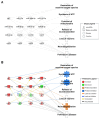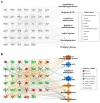Biological Function Analysis of MicroRNAs and Proteins in the Cerebrospinal Fluid of Patients with Parkinson's Disease
- PMID: 39769025
- PMCID: PMC11678473
- DOI: 10.3390/ijms252413260
Biological Function Analysis of MicroRNAs and Proteins in the Cerebrospinal Fluid of Patients with Parkinson's Disease
Abstract
Parkinson's disease (PD) is a progressive neurodegenerative disorder characterized by alpha-synuclein aggregation into Lewy bodies in the neurons. Cerebrospinal fluid (CSF) is considered the most suited source for investigating PD pathogenesis and identifying biomarkers. While microRNA (miRNA) profiling can aid in the investigation of post-transcriptional regulation in neurodegenerative diseases, information on miRNAs in the CSF of patients with PD remains limited. This review combines miRNA analysis with proteomic profiling to explore the collective impact of CSF miRNAs on the neurodegenerative mechanisms in PD. We constructed separate networks for altered miRNAs and proteomes using a bioinformatics method. Altered miRNAs were poorly linked to biological functions owing to limited information; however, changes in protein expression were strongly associated with biological functions. Subsequently, the networks were integrated for further analysis. In silico prediction from the integrated network revealed relationships between miRNAs and proteins, highlighting increased reactive oxygen species generation, neuronal loss, and neurodegeneration and suppressed ATP synthesis, mitochondrial function, and neurotransmitter release in PD. The approach suggests the potential of miRNAs as biomarkers for critical mechanisms underlying PD. The combined strategy could enhance our understanding of the complex biochemical networks of miRNAs in PD and support the development of diagnostic and therapeutic strategies for precision medicine.
Keywords: Parkinson’s disease; cerebrospinal fluid; integrated omics; microRNA; proteomes.
Conflict of interest statement
The authors declare no conflicts of interest.
Figures



Similar articles
-
Integrative Metabolome and Proteome Analysis of Cerebrospinal Fluid in Parkinson's Disease.Int J Mol Sci. 2024 Oct 23;25(21):11406. doi: 10.3390/ijms252111406. Int J Mol Sci. 2024. PMID: 39518959 Free PMC article. Review.
-
MicroRNAs in Cerebrospinal Fluid as Potential Biomarkers for Parkinson's Disease and Multiple System Atrophy.Mol Neurobiol. 2017 Dec;54(10):7736-7745. doi: 10.1007/s12035-016-0253-0. Epub 2016 Nov 14. Mol Neurobiol. 2017. PMID: 27844283 Free PMC article.
-
Cerebrospinal Fluid Metabolome in Parkinson's Disease and Multiple System Atrophy.Int J Mol Sci. 2022 Feb 7;23(3):1879. doi: 10.3390/ijms23031879. Int J Mol Sci. 2022. PMID: 35163800 Free PMC article. Review.
-
Deployment of Label-Free Quantitative Olfactory Proteomics to Detect Cerebrospinal Fluid Biomarker Candidates in Synucleinopathies.Methods Mol Biol. 2019;2044:273-289. doi: 10.1007/978-1-4939-9706-0_17. Methods Mol Biol. 2019. PMID: 31432419
-
Transcriptomics and Proteomics Approach for the Identification of Altered Blood microRNAs and Plasma Proteins in Parkinson's Disease.Cell Mol Neurobiol. 2023 Oct;43(7):3527-3553. doi: 10.1007/s10571-023-01362-4. Epub 2023 May 23. Cell Mol Neurobiol. 2023. PMID: 37219663 Free PMC article.
Cited by
-
Integrative Analysis of Metabolome and Proteome in the Cerebrospinal Fluid of Patients with Multiple System Atrophy.Cells. 2025 Feb 12;14(4):265. doi: 10.3390/cells14040265. Cells. 2025. PMID: 39996738 Free PMC article. Review.
References
-
- Kouli A., Torsney K.M., Kuan W.-L. Parkinson’s Disease: Etiology, Neuropathology, and Pathogenesis. Exon Publications; Brisbane City, QLD, Australia: 2018. pp. 3–26.
Publication types
MeSH terms
Substances
Grants and funding
LinkOut - more resources
Full Text Sources
Medical

